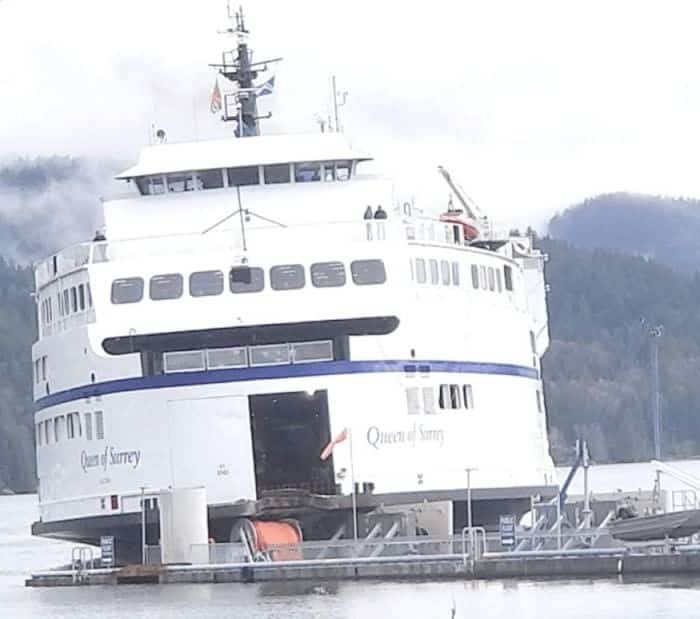 Queen of Surrey waiting for a tug to arrive to tow it off the Stormaway dock / Buddy Boyd
Queen of Surrey waiting for a tug to arrive to tow it off the Stormaway dock / Buddy Boyd
BC Ferries says a ŌĆ£procedural errorŌĆØ was the main cause of a March 26 incident involving the Queen of Surrey.
The Surrey hit the pontoon structure at as it was coming into LangdaleŌĆÖs Berth 1 on the first trip from Horseshoe Bay.
More than 285 passengers were stranded on board for around 10 hours, and service on the route was severely disrupted as crews worked to free the ship, which suffered damage to the lower car deck as well as the hull and the steel plating around a rudder.
The Surrey had returned from a refit just two days before the accident, and Darren Johnston, executive director of fleet operations, told Coast Reporter that a recently completed BC Ferries internal investigation found no ŌĆ£defects or deficienciesŌĆØ with the ship or its systems.
ŌĆ£The primary cause of the incident itself was a procedural error by the bridge team,ŌĆØ Johnston. ŌĆ£That led to the ship inadvertently not being turned correctly onto its approach track and not being slowed early enough to the appropriate arrival speed.ŌĆØ
Johnston said had the ship been travelling at the correct ŌĆ£arrival speedŌĆØ it would likely have been possible to stop the ferry before it made contact with the pontoon.
According to Johnston, the individual members of the bridge team were experienced, but this was one of the first times theyŌĆÖd all worked together and that also contributed to the procedural error.
ŌĆ£The main [response to the investigation] is the placement of an additional officer on the bridge so that we have appropriate ability within the navigational team to do the cross-checking and verification of vessel position and speed information during the arrival,ŌĆØ Johnston said, adding that this new procedure has been applied across the fleet.
BC Ferries also reviewed its passage plans, the navigational tracks set out for each crossing, and made minor adjustments.
Johnston said the company could not comment on whether any crew members faced disciplinary action as a result of the Surrey incident.
ŌĆ£We accepted all of the findings of our internal inquiry and have worked hard and diligently to start implementing them. A number have already been implemented ŌĆ” and most importantly weŌĆÖre thankful that no one was injured,ŌĆØ he said.
The BC Ferries review also looked at what happened after the accident.
ŌĆ£We were pleased with the response to the incident in terms of how we were able to manage the directly affected passengers and those that were subsequently affected or impactedŌĆ” Everything that could be done was done,ŌĆØ Johnston said.
The service disruption, he said, highlighted the need for a second full-time ship on the route, something BC Ferries hopes to do in the next five years.
The Transportation Safety Board decided against conducting an investigation into the March 26 incident, declaring it a ŌĆ£Class 5 occurrence,ŌĆØ where a formal investigation and report ŌĆ£has little likelihood of identifying new safety lessons that will advance transportation safety.ŌĆØ
The Queen of Surrey returned to the Langdale-Horseshoe Bay route in late April. BC Ferries said the cost of repairs was $2.4 million and that the company was covered by insurance.


